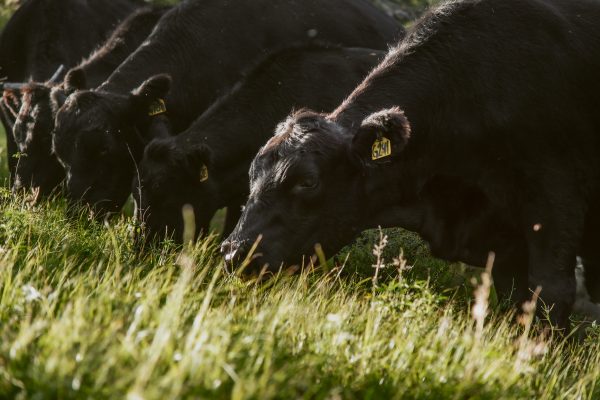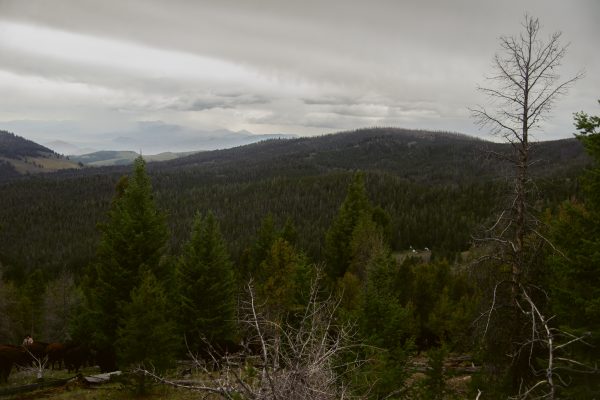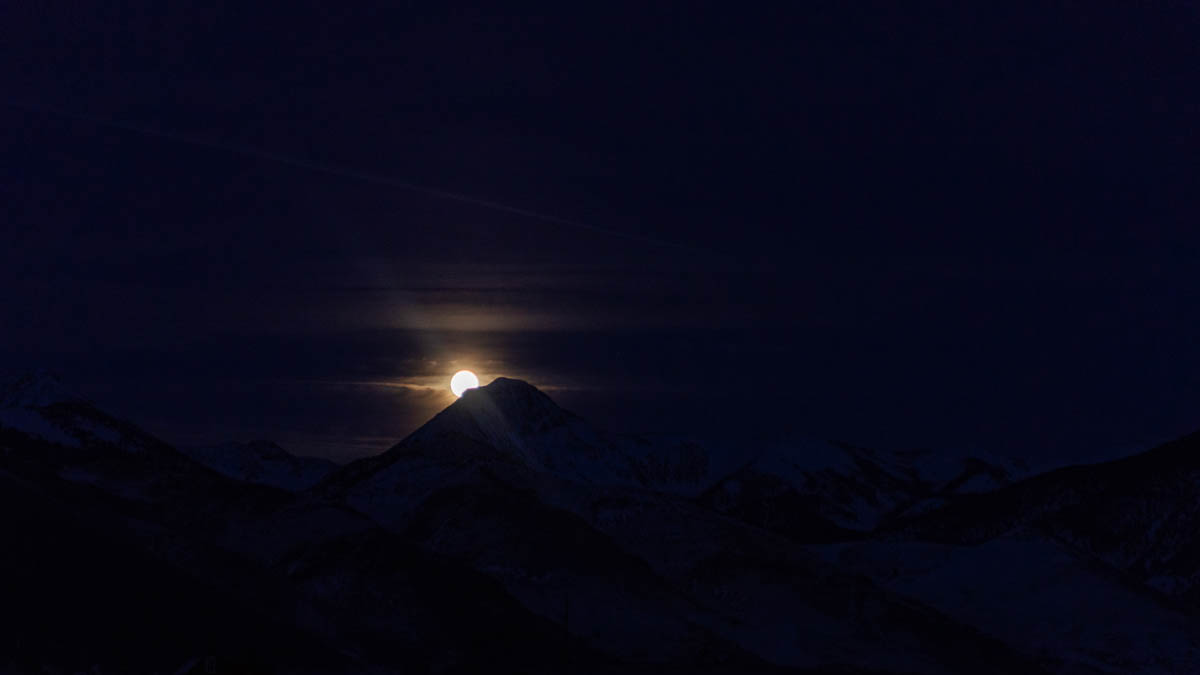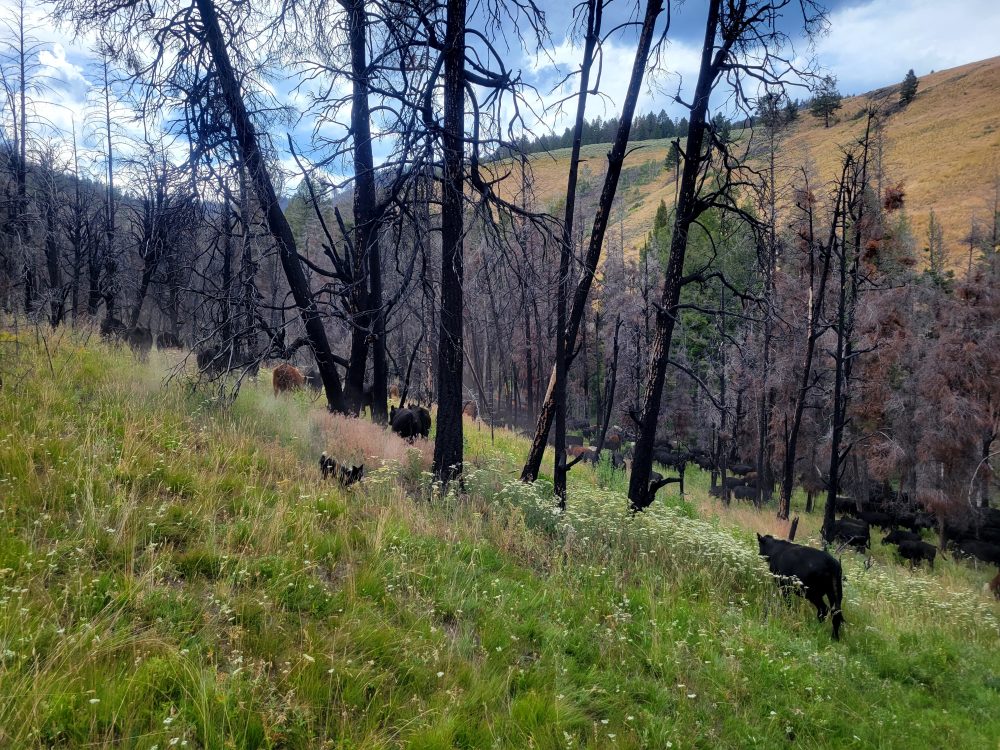The May sun was already down; it was going to be dark soon. We were running out of time. As Josh and I meandered and bounced the old pickup through the 200-acre hay meadow, our eyes scanned the verdant shag carpet of spring grass that was coming up with abandon. I was thankful it was early spring; the grass wasn’t too deep or thick to completely conceal a calf. But we needed the light. Already much of the swales were in shadow. Cruising around the big meadow in the coming darkness looking for a swatch of black among the shadows would be a fool’s errand. Not that we haven’t done it; we just didn’t want to do it again.
 “There.” I followed Josh’s finger through the windshield and swung the steering wheel in the direction of the thin black line that looked like it could mark the backline an Angus baby. It was an experienced eye that spotted it; Josh was a keen observer and knew just what we were looking for. As I pulled the pickup alongside, the calf didn’t move. Elk and deer newborns I have found in the nearby mountains do the same thing. Instinct tells these babies to lie prone and limp as though dead, as movement is the very first thing that a predator picks out. If they moved, they would be dinner before they celebrated their second day of life. It was no different here. Coyotes and the occasional mountain lion or wolf would happily seat themselves at this gourmet place setting on our valley ranch.
“There.” I followed Josh’s finger through the windshield and swung the steering wheel in the direction of the thin black line that looked like it could mark the backline an Angus baby. It was an experienced eye that spotted it; Josh was a keen observer and knew just what we were looking for. As I pulled the pickup alongside, the calf didn’t move. Elk and deer newborns I have found in the nearby mountains do the same thing. Instinct tells these babies to lie prone and limp as though dead, as movement is the very first thing that a predator picks out. If they moved, they would be dinner before they celebrated their second day of life. It was no different here. Coyotes and the occasional mountain lion or wolf would happily seat themselves at this gourmet place setting on our valley ranch.
I knelt down and stroked the baby’s back. Its newborn softness was a combination of black silk and velvet. “That mom sure cleaned this kid off,” I said to Josh. By the cleanliness of the smooth fur, it was evident that the mom really wanted her baby. She had taken care of it, but now, was nowhere to be seen. We had both been around other calves, usually dropped on the ground by a crazed young heifer cow. Usually these first-time moms will calm down and, within a few days, proudly protect baby. If not, we intervene and take care of the calf.
I scooped my hands under the 85 lb bull calf. It hung limp, as instinct told it to. Playing dead. “Well, let’s get him to his mama.”
Josh jumped in the driver’s seat, and I shoved the long lanky calf in on the bench seat between us. He would be safe here. We both knew that limp can turn to upright and running at any minute. If we put him in the back, he could decide to go erect and try to run and fall out of the truck.
We headed out across the bumpy meadows, toward the river bottoms. On the other side of the ranch was where we guessed Mom had ended up, with the rest of her herd.
Our suspicions had started earlier that  day, in the first light of morning that something was amiss.I was up at the bunkhouse at sunup to line out Josh and Bob. After talking over the day’s work, Josh and Bob mentioned an errant cow, alone, and on the other side of the ranch from the others. Josh spotted her before our meeting. “I went down there to see who it was—it was X6. She looked like she might be calving down there.”
day, in the first light of morning that something was amiss.I was up at the bunkhouse at sunup to line out Josh and Bob. After talking over the day’s work, Josh and Bob mentioned an errant cow, alone, and on the other side of the ranch from the others. Josh spotted her before our meeting. “I went down there to see who it was—it was X6. She looked like she might be calving down there.”
“How’d she get over there?” I asked.
“She must have jumped over low places in the electric fence in the night,” said Josh.
“Anyway, when I went down there to check on her, she was running all the way back to the herd.” It was about a half a mile and had to jump two fences (most of the fencing on Alderspring is a single strand of electric fence- not too tough to jump for an athletic young cow). Perhaps something spooked her down there to leave her baby, like a killdeer would—leading a would-be predator away from her nest with a counterfeit broken wing display.
I’d been hearing our Great Pyrenees dogs barking most of the early morning before light; I was guessing coyotes were out there looking for afterbirth, and maybe the calf. A later morning check by Josh found her out with the rest of the cowherd, acting as if nothing had happened the night before. She had her head down grazing.
Usually, a new mom will go find her calf after a bit. We waited all day for her to remember her calf and go back and get it. But it was getting toward evening, and she showed no signs of going looking.
So, we would bring the calf to her. We bumped along the river bottom through a low gate and into the 100-acre calving pasture. Baby was handling the rocking drive quite well in my lap, except for peeing a quart of warm liquid on my blue jeans. Then, we hit the muck, and Josh remembered that the 4-wheel drive was recently broken on this pickup. We were completely stuck, wheels spinning in slick and sticky clay. We gave a half-hearted try at locking the front hubs for 4-wheel drive. Nothing.
“I guess we’ll have to get the chains on,” Josh quipped.
Great. I thought chain season was over.
I left Junior on the front seat, and Josh and I both grabbed a set of dried mud encrusted “jewelry,” as we lovingly called them. We were good at chaining up the tires and did it often on mountain passes in the winter. Winter chaining was almost pleasant- lay down in the clean snow, and after a few minutes of finagling, drive off into the sunset, jewelry jingling a happy tune like sleigh bells. Chained up tires could chew their way through almost anything.
But this was anything but clean snow. It was mud, laced with cow poop. We both laid down in it and reached behind the slime chucked tires with chain. I smiled as I felt the cold wet soak through my blue-jeaned butt and flannel shirt. We live life in and around soil and cow poop. We touch it, lay in it, breathe it, and occasionally (inadvertently) eat it. I watch my daughters do the same. (I think it is why most of them have never been to a doctor. They rarely even get the flu or if they do, I can’t recall them spending their day in bed. Their immune systems must be among the most robust in the species Homo sapiens.)
In five minutes, we were underway. I stroked Junior’s luxuriant fur. The heat was on in the truck and he stretched out between Josh and me on the plush pickup bench seat, legs lazily swinging over the seat edge like a little kid in a church pew. I was less comfortable with calf urine wetting the front of my jeans and mud and manure wetting the back, but I was happy with our little buddy. Josh was stoic about his state of physical well-being. He is characteristically wordless about personal comfort. He just smiles.
 In another few minutes, we were to the cow herd. Josh swung the pickup broadside about 50 feet away from the closest black mamas. One cow took 3 steps closer to us as we came to a stop. It was X6. Her head was up, and she looked a little cranky. I have no doubt her udder was getting a little tight and uncomfortable, because she should have fed her baby hours ago.
In another few minutes, we were to the cow herd. Josh swung the pickup broadside about 50 feet away from the closest black mamas. One cow took 3 steps closer to us as we came to a stop. It was X6. Her head was up, and she looked a little cranky. I have no doubt her udder was getting a little tight and uncomfortable, because she should have fed her baby hours ago.
I also have no doubt that she absolutely knew what we were doing there. Cows know stuff. She was a mother, waiting at the bus stop for her child, on the way back from his first day at school. In my mind’s ear, she spoke: “Well, it’s about time.
You stupid two leggers just stand right on the verge of absolute incompetency. Where the heck have you guys been? I’ve been waiting here all day.” She wagged her highly held head in anger as if to emphasize.
I wanted to argue with her with words like “What were you even thinking leaving your kid alone out there in the middle of nowhere anyway? Talk about stupid,” but she was talking over me, and wouldn’t even listen.
I pushed open the door and grabbed little blackie. I put his limp legs under him and straightened and locked his knee and hock joints so he would stand upright. He got it figured out and took a step. Mom bellered an angry yet full of joy
“Junior!”
Baby answered with a loving and now realizing “he’s really hungry” bawl back.
As mom made trotted her way to Junior, I turned to Josh. “Let’s get out of here.” We both knew that two things needed to happen, and they might not if we kept around: mom needed to sniff baby carefully to make sure in her own mind that it was her own, and she needed to let baby eat. And she needed to stand still so the calf could latch on to milk bar; cow likely wouldn’t stand still if we were around.
You see, our mama cows are still mostly wild animals, and they see us still as predators. We like it that way; they can protect their own better than we can. If we tame them down, they may get too trusting of real predators. So, we let them be wild. On the other hand, our beeves that we craft for beef live and graze alongside of us horseback for most of their life after they wean themselves off mama. So, they do get quite trusting of us. We can even pet some of them, but very few are the mama cows that would allow that. They aren’t coddled and comforted dairy cows named Bonnie. These have more in common with wild buffalo moms. Many would not hesitate to inflict pain if you messed with baby.
Josh stopped a hundred yards away, and we watched in the mirrors. She still held her head up in cautious resentment toward us (nice way to say thank you!) but was letting the kid suck. All was well. Like they say on those human birth announcements, “Mom and baby are fine.”
It’s not often we have to intervene in  calving. The mama cows really got it down; all we do is ensure all their needs are met; clean water, plenty of green grass, space to roam and find a quiet place to calve. Most of them have never been in a barn. They live in the wild in their minds and their reality, relying on ancient instincts.
calving. The mama cows really got it down; all we do is ensure all their needs are met; clean water, plenty of green grass, space to roam and find a quiet place to calve. Most of them have never been in a barn. They live in the wild in their minds and their reality, relying on ancient instincts.
To us, it is husbandry. It’s caring for wild landscapes that allow our beeves to live a pretty wild life, free of stress, in open space. They are not made for confinement in barn, stall or corral. Humankind has sadly ignored many of the attributes that we view as important for our own wellness when it comes to animals. We’ve reduced animals to “production units” thinking mostly about feed efficiency and reducing costs, but fail to think about the psychological, social or emotional well-being of our animal charges.
Cows, for one, are extremely social animals, and a vital part of their wellness is impacted when we put them in private stalls or concrete feedlots. They are also natural balancers of their nutritional needs, selecting the plants that day that most contribute to their wellness. In a feedlot, selection is limited to choosing whether or not to eat the premix ration that the nutritionist prescribed. It’s no wonder industrially produced beef is missing important wellness attributes for the human consumer as well.
 The humane attributes of nutritional, emotional, social, and psychological wellbeing of the animals that feed us are some of the consumer driven reasons why there is a grass fed revolution. But beware: The efficiency experts in corporate boardrooms are already compromising the great wellness potential in grass fed when they sacrifice husbandry to what accounting demands. Rations in the feedlot are being retooled to meet the letter of “grassfed” but the industrial model remains the same. They will apply the principles of economy of scale. Instead of 1-300 beeves on wild pastures, they will raise 100,000 to 3 million in a grass-fed finishing paradigm that looks very suspiciously like the feedlot that we disparage today. The consumer is none the wiser.
The humane attributes of nutritional, emotional, social, and psychological wellbeing of the animals that feed us are some of the consumer driven reasons why there is a grass fed revolution. But beware: The efficiency experts in corporate boardrooms are already compromising the great wellness potential in grass fed when they sacrifice husbandry to what accounting demands. Rations in the feedlot are being retooled to meet the letter of “grassfed” but the industrial model remains the same. They will apply the principles of economy of scale. Instead of 1-300 beeves on wild pastures, they will raise 100,000 to 3 million in a grass-fed finishing paradigm that looks very suspiciously like the feedlot that we disparage today. The consumer is none the wiser.
But at Alderspring, we won’t be eating at that feedbunk. We’ll still be here, raising beef the way we believe is right, as long as there are partners like you who appreciate the difference. It’s about letting a cow be a cow. We simply provide a wide range of choice, and she picks her way. And that makes all the difference.
Thanks for being our partners.
Glenn, Caryl, Girls and Cowhands at Alderspring.







Leave a Reply